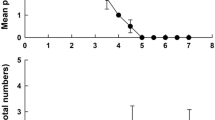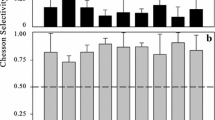Abstract
Mesocosms (∼4.5 m3) situated in a closed bay area were used to investigate the effect of protozoan predation on nonindigenous bacteria. Pseudomonas fluorescens strain Agl was released into mesocosms as a single inoculum of 1 × 105 cells ml−1 (final concentration) or as four inocula (same concentration each) at intervals of 3 days. Mesocosms that had received growth media corresponding to the inoculum served as controls. Numbers of P. fluorescens Ag1 decreased rapidly whether released as single or multiple inocula. Direct estimation of protozoan predation using fluorescently labeled P. fluorescens from log phase and starved cultures, respectively, revealed that natural populations of heterotrophic nanoflagellates consumed substantial amounts of the nonindigenous bacterial strain. The volume of fluorescently labeled cells prepared from starved cells was 68% of log phase cell volume, but the individual clearance of the small cells was five to seven times higher than that of the log phase bacteria. The natural populations of nanoflagellates consumed 34–62% of P. fluorescens Ag1 daily if starved bacteria were offered as food, and 3–13% if the cells were in the logarithmic growth phase. This suggests that the effect of protozoan predation on nonindigenous bacterial strains is substantial because cultured bacteria are likely to starve in natural environments. The addition of P. fluorescens Ag1 and the growth medium enhanced the abundance of natural bacteria, chlorophyll a, heterotrophic nanoflagellates, and ciliates, but it did not improve the growth conditions for the released strain. The effects on the indigenous populations were more pronounced after addition of fresh medium than following inoculation with cells, which possibly was due to the lower nutrient content of spent medium. However, these results, based on direct estimation of protozoan predation on log phase and starved nonindigenous bacteria, point to the conclusion that mortality induced by bacterivorous predators is the key factor determining removal of nonindigenous bacteria introduced in natural aquatic systems.
Similar content being viewed by others
References
Ahl T, Christoffersen K, Riemann B, Nybroe O (1995) A combined microcosm and mesocosm approach to examine factors affecting survival and mortality of Pseudomonas fluorescens Ag1 in sea water. FEMS Microbial Ecol. in press
Barcina I, Ayo B, Muela A, Egea L, Iriberri J (1991) Predation rates of flagellates and ciliated protozoa on bacterioplankton in a river. FEMS Microbiol Ecol 85:141–150
Barcina I, Gonzalez JM, Iriberri J, Egea L (1991) Role of protozoa in the regulation of enteric bacteria populations in seawater. Mar Microbial Food Webs 5:179–187
Berninger U-G, Caron DA, Sanders RW, Finlay B (1991) Heterotrophic flagellates of planktonic communities: their characteristics and method of study. In: Patterson DJ and Larsen J (Eds) The biology of free-living heterotrophic flagellates. The Systematics Association special volume No. 45. Clarendon Press, Oxford, UK, pp 39–57
Bott TL, Kaplan LA (1993) Persistence of a surrogate for a genetically cellulytic microorganism and effects on aquatic community and ecosystem properties: mesocosm and stream comparisons. Can J Microbiol 39:686–700
Brettar I, Höfle M (1992) Influence of ecosystematic factors on survival of Escherichia coli after large-scale release into lake water mesocosmos. Appl Environ Microbiol 58:2201–2210
Brettar I, Ramos-Gonzalez MI, Ramos JL, Hofle MG (1994) Fate of Pseudomonas putida after release into lake water mesocosms: different survival mechanisms in response to environmental conditions. Microb Ecol 27:99–122
Christoffersen K (1994) Do heterotrophic nanoflagellates feed on picoplankton in rhythms? Mar Microbial Food Webs 8:111–123
Christoffersen K, Riemann B, Søndergaard M, Haslund OH (1995) Growth, production, and protozoan grazing of autotrophic and heterotrophic picoplankton in estuarine enclosures. Mar Microbial Food Webs. Manuscript submitted
Fenchel T (1982) Ecology of heterotrophic microflagellates. IV. Quantitative occurrence and importance as bacterial grazers. Mar Ecol Prog Ser 9:35–42
Fenchel T (1987) Ecology of protozoa. The biology of free-living phagotrophic protists. Brock/Springer, Madison, Wisconsin.
Garcia-Lara J, Menon P, Servais P, Billen G (1991) Mortality of fecal bacteria in seawater. Appl Environ Microbiol 57:885–888
Gonzalez JM, Iriberri J, Egea L, Barcina I (1990) Differential rates of digestion of bacteria by freshwater and marine phagotropic protozoa. Appl Environ Microbiol 56:1851–1857
Gonzalez JM, Iriberri J, Egea L, Barcina I (1992) Characterization of culturability, protistan grazing, and death of enteric bacteria in aquatic ecosystems. Appl Environ Microbiol 58:998–1004
Gonzalez JM, Sherr EB, Sherr BF (1990) Size-selecting grazing on bacteria by natural assemblages of estuarine flagellates and ciliates. Appl Environ Microbiol 56:583–589
Gurijala RK, Alexander M (1990) Explanation for the decline of bacteria introduced into lake water. Microb Ecol 20:231–244
Hobbie J (1977) Use of nuclepore filters for counting bacteria by fluorescence microscopy. Appl Environ Microbiol 56:2370–2373
Höfle M (1992) Bacterioplankton community structure and dynamics after large-scale release of nonindigenous bacteria as revealed by low-molecular-weight-RNA analysis. Appl Environ Microbiol 58:3387–3394
Kandel A, Christoffersen K, Nybroe O (1993) Filtration rates of Daphnia cucullata on Alcaligenes eutrophus JMP134 estimated by a fluorescent antibody method. FEMS Microbiol Ecol 12:1–8
Landry MR, Lehner-Foumier JM, Sundstrom JA, Fagerness VL, Selph KE (1991) Discrimination between living and heat-killed prey by a marine zooflagellate, Paraphysomonas vestita (Stokes). J Exp Mar Biol Ecol 146:139–151
Mallory LM, Yuk C-S, Liang L-N, Alexander M (1983) Alternative prey: a mechanism for elimination of bacterial species by protozoa. Appl Environ Microbiol 46:1073–1079
Morgan JAW (1990) Genetic engineering of microorganisms: free release into the environment. In: Freshwater Biological Association Annual report. Freshwater Biological Association, pp. 91–107 Ambleside, U.K.
McCambridge J, McMeekin TA (1980) Relative effects of bacterial and protozoan predators on survival of Escherichia coli in estuarine water samples. Appl Environ Microbiol 40:907–911
Nybroe O, Christoffersen K, Riemann B (1992) Survival of Bacillus licheniformis in seawater model ecosystems. Appl Environ Microbiol 58:252–259
Nybroe O, Johansen A, Laake M (1990) Enzyme-linked immunosorbent assays for detection of Pseudomonas fluorescens in sediment samples. Lett Appl Microbiol 11:293–296
Nyström T, Albertson NH, Flärdh K, Kjelleberg S (1990) Physiological and molecular adaptation to starvation and recovery from starvation by the marine Vbrio sp. S14. FEMS Microbiol Ecol 74:129–140
Scanferlato VS, Lacy GH, Cairns J Jr (1990) Persistence of genetically engineered Erwinia carotovora in perturbed and unperturbed aquatic microcosms and effect on recovery of indigenous bacteria. Microb Ecol 20:11–20
Simek K, Chrzanowski TH (1992) Direct and indirect evidence of size-selective grazing on pelagic bacteria by freshwater nanoflagellates. Appl Environ Microbiol 58:3715–3720
Author information
Authors and Affiliations
Additional information
Correspondence to: K. Christoffersen.
Rights and permissions
About this article
Cite this article
Christoffersen, K., Ahl, T. & Nybroe, O. Grazing of nonindigenous bacteria by nano-sized protozoa in a natural coastal system. Microb Ecol 30, 67–78 (1995). https://doi.org/10.1007/BF00184514
Received:
Revised:
Issue Date:
DOI: https://doi.org/10.1007/BF00184514




